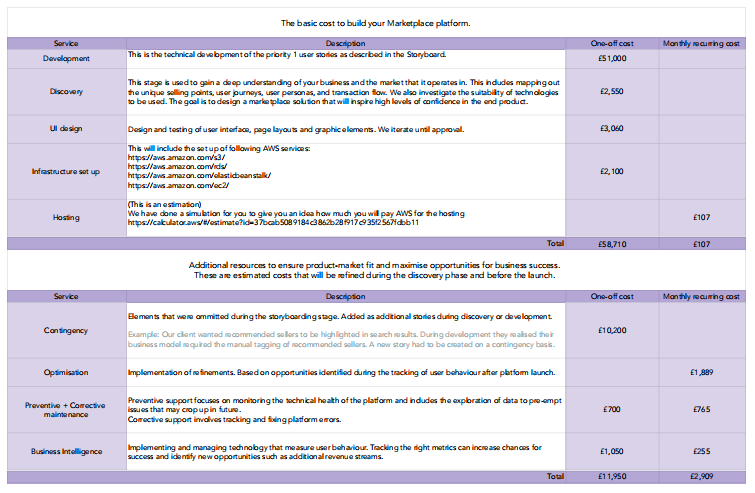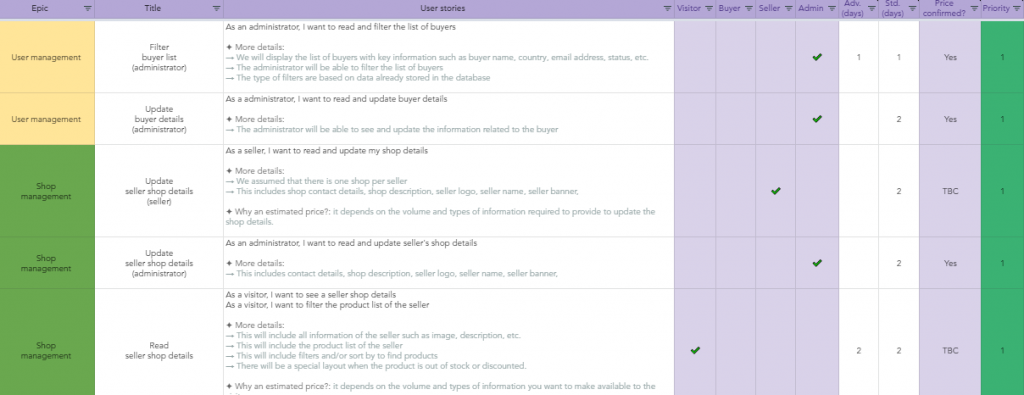One of the greatest causes of marketplace startup failure is insufficient budget planning. This is often the result of conflating the initial setup costs with a full product development road map that is geared towards product/market fit. Many startups fail to make provision for dynamic and recurring items that are key to their platform’s successful operation and optimisation.
We have previously written about marketplace development costs. That mostly covered the initial design and implementation of technology. However, this basic cost should not be seen as a static or final amount.
Marketplace success, especially product/market fit, is dependent on ongoing iteration and experimentation. Startups should therefore also include the cost of these processes in their marketplace development budget.
CobbleWeb has created a budget calculator to make it easier to estimate the various costs for custom marketplace development that will ensure a higher chance of success.

The basic cost to build your marketplace platform
As we mentioned in our previous post, custom marketplace development can cost anywhere from £25,000 to £100,000 plus. This includes the following once-off services:
Discovery
This stage is used to gain a deep understanding of your business and the market that it operates in. This includes mapping out the unique selling points, user journeys, user personas, and transaction flow.
We also investigate the suitability of technologies to be used. The goal is to design a marketplace solution that will inspire high levels of confidence in the end product. The discovery stage is a good example of the powerful extra value that custom development provides.
Development
This is the technical implementation of the user stories as defined in a storyboard created during the discovery phase. User stories are the building blocks of any development road map and are grouped under top-level categories (epics) that cover the main user flows of your marketplace. e.g. user management, product management, navigation, buying funnel and shipping.
Knowing when to prioritise which user stories is an important part of your budget calculation. As can be seen from the storyboard example below there are a number of variables that can affect the initial development cost.
Priority one items are those user stories that will be included in the first release of your platform. Changing the priority will update the total development cost in the calculator.
The number of advanced and standard days will also affect the development cost. Advanced days comprise the estimated workload for senior developers with seven plus years experience, while standard days are the workload for junior developers with three to seven years experience. The more complex the user story or feature, the more advanced days will be required.

UX/UI design
During this phase the required user interfaces, page layouts and graphic elements are designed for testing during the development stage. Designs are then iterated based on user feedback till sufficient results are achieved.
Infrastructure set up
This is a once-off cost that covers the setting up of platform infrastructure through scalable cloud-based platforms such as Amazon Web Services. Basic infrastructure usually comprises data storage (Amazon S3), database engines (Amazon RDS), and virtual servers (Amazon EC2).
Hosting
This is a recurring cost and will depend on platform traffic. In general it’s best to use a scalable service like AWS to ensure continuity and minimal service disruptions.
Additional resources
The following additional services promote product-market fit and maximise opportunities for business success. These are usually estimated costs that will be refined during the discovery phase and before the launch.
Contingency
Contingency costs cover those elements that were omitted during the initial storyboarding stage. They are then added as additional user stories during development.
Example: Our client wanted recommended sellers to be highlighted in search results. During development they realised their business model required the manual tagging of recommended sellers. Thus, a new story had to be created on a contingency basis.
Optimisation
Optimisation costs are incurred with the implementation of refinements that drive further marketplace growth. These refinements are based on opportunities identified during the tracking of user behaviour after platform launch.
Preventive & corrective maintenance
Preventive support focuses on monitoring the technical health of the platform. It includes the exploration of data to pre-empt issues that may crop up in future. Corrective support involves tracking and fixing platform errors.
Business intelligence
This is the cost for implementing and managing technology that measures user behaviour. Tracking the right metrics can increase chances for success and identify new opportunities such as additional revenue streams.
Creating a detailed development budget for your marketplace startup not only gives you a better idea of the total costs involved, it helps you clarify your business case and development priorities. A software development agency that specialises in custom marketplaces can help you make sense of this critical step.

